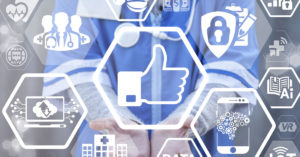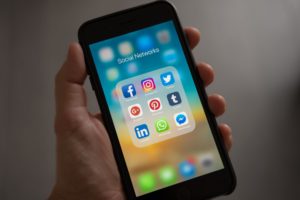 The power of social media to exponentially amplify good, bad, and even neutral patient experiences and health information simply can’t be ignored today. Despite its prevalence in most of our personal lives and leisure time, a surprising number of practice managers and healthcare organizations still ask why social media matters in healthcare. If you’re still asking why social media matters to your practice, these statistics will provide your answer… or your ultimatum. If you know and respect the value of a social media strategy for your healthcare organization, these stats will help you refine and refresh your approach to online patient engagement.
The power of social media to exponentially amplify good, bad, and even neutral patient experiences and health information simply can’t be ignored today. Despite its prevalence in most of our personal lives and leisure time, a surprising number of practice managers and healthcare organizations still ask why social media matters in healthcare. If you’re still asking why social media matters to your practice, these statistics will provide your answer… or your ultimatum. If you know and respect the value of a social media strategy for your healthcare organization, these stats will help you refine and refresh your approach to online patient engagement.
 As of July 2021, there are over 4.4 billion people on social media, a number that more than doubled over the past six years. (1)
As of July 2021, there are over 4.4 billion people on social media, a number that more than doubled over the past six years. (1)- Nearly 90% of all adults in the USA search for health information on Facebook, Twitter, YouTube, and other social media sites. (2)
- Of the patients who use social media for health information, a study by PwC Health Research determined that 42% seek provider / practice reviews, 32% post about the health experiences of friends and family, and 24% view health-related media. (3)
- Over 75% of Americans use social media to research their health symptoms. (3)
- 90% of individuals aged 18 to 24 stated they trust medical info shared on their social feeds. (4)
- Younger internet users aged 18 to 24 are twice as likely to use social media to discuss health issues than their elders in the 45 to 54 demographic. (5)
- 32% of Millenials took a health-related action based on information consumed on social media platforms. (6)
- Nearly all parents use social media, and the majority (68%) of them use social media for health information. (7)
- 28% of health conversations on Facebook support a health-related cause. 16% share health-related videos or images. (4)
- More than 80% of patients seek out provider / practice reviews on social media outlets after being referred by another person or provider. (8)
 After a slow initial adoption rate (and some help from factors outside their control) healthcare facilities today recognize the need for a social media presence. Google simply stopped waiting for many organizations to onboard, automatically adding hospitals, practices, and even individual doctors to their rating platform alongside other businesses and entities. Yelp and Facebook each took a similar approach, though it’s worth noting that many hospitals voluntarily incorporated a Facebook presence into their marketing and communications as early as 2014. (9)
After a slow initial adoption rate (and some help from factors outside their control) healthcare facilities today recognize the need for a social media presence. Google simply stopped waiting for many organizations to onboard, automatically adding hospitals, practices, and even individual doctors to their rating platform alongside other businesses and entities. Yelp and Facebook each took a similar approach, though it’s worth noting that many hospitals voluntarily incorporated a Facebook presence into their marketing and communications as early as 2014. (9)
With an increased focus on patient engagement, these numbers rose quickly in the last five years. Most organizations not only see the value of incorporating social media into their overall reach and communications strategy, they increasingly endeavor to broaden their social media footprint. (9)
 The Centers for Disease Control and Prevention (CDC) maintains a Social Media Toolkit that encourages healthcare leaders to develop a social media strategy and guidelines in order to effectively utilize third-party public forums. (10)
The Centers for Disease Control and Prevention (CDC) maintains a Social Media Toolkit that encourages healthcare leaders to develop a social media strategy and guidelines in order to effectively utilize third-party public forums. (10)
- Increase the timely dissemination and potential impact of health and safety information.
- Leverage audience networks to facilitate information sharing.
- Expand reach to include broader, more diverse audiences.
- Personalize and reinforce health messages that can be more easily tailored or targeted to particular
audiences. - Facilitate interactive communication, connection and public engagement.
- Empower people to make safer and healthier decisions.
The value of social media and its impact on the healthcare industry is still continuously and rapidly evolving. It can be utilized to complement and sometimes even replace traditional communications, increase patient engagement, trust, and credibility, share content in new spaces, reach new audiences, or communicate and share in real-time. Regardless of an organization’s level of participation, social media is an essential and trusted source of information and health-related content for billions of patients.

Please let us know if you have comments or questions, and subscribe to our Email Updates so that you can be assured to receive Thinking Thursdays TIPs.
Thank you!
Jerry
Jerry L. Stone
Co-Founder/COO
MedicalGPS, LLC
References:
- https://backlinko.com/social-media-users
- Bishop M. (2019) Healthcare Social Media for Consumer Informatics. In: Edmunds M., Hass C., Holve E. (eds) Consumer Informatics and Digital Health. Springer, Cham. https://doi.org/10.1007/978-3-319-96906-0_4
- https://www.pwc.com/us/en/industries/health-industries/library.html
- https://etactics.com/blog/social-media-and-healthcare-statistics
- https://inbound.hargerhowe.com/blog/top-healthcare-recruitment-social-media-secrets
- https://www.aafp.org/news/practice-professional-issues/20180608commsurveys.html
- https://pubmed.ncbi.nlm.nih.gov/31648059/
- https://www.doctor.com/cxtrends2020
- https://www.jmir.org/2014/11/e264
- https://www.cdc.gov/socialmedia/tools/guidelines/pdf/socialmediatoolkit_bm.pdf


Yeah, social media is gradually spreading its impacts on the different sectors. Here health care is no exception. By the way, thanks for sharing this informative type of post with us.